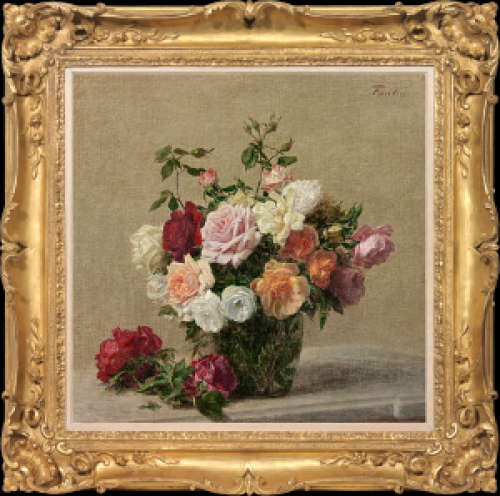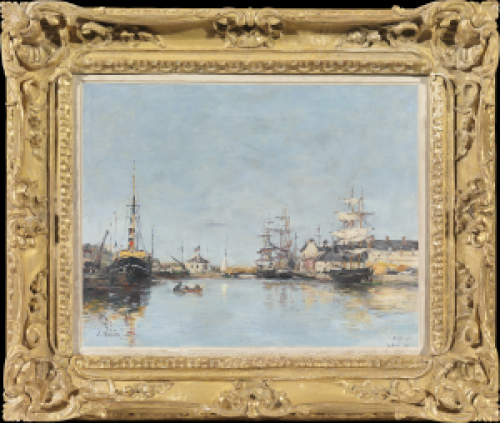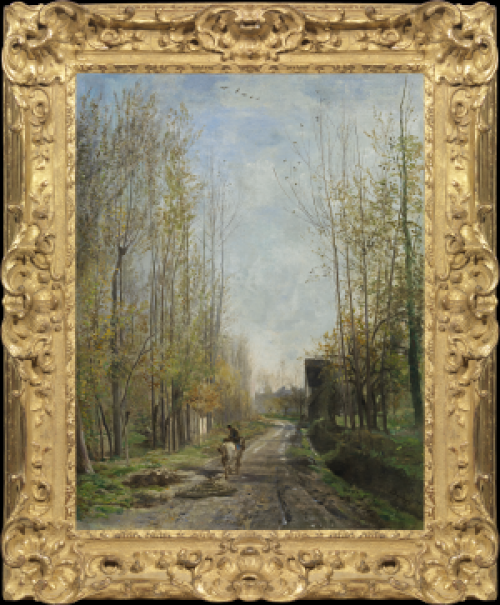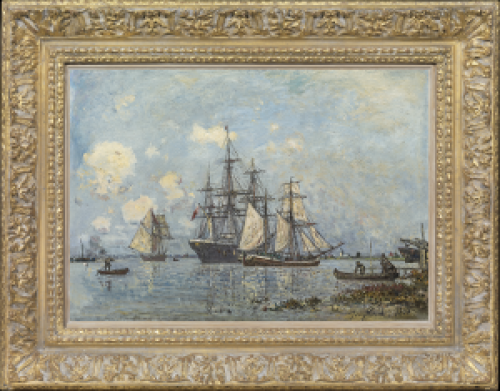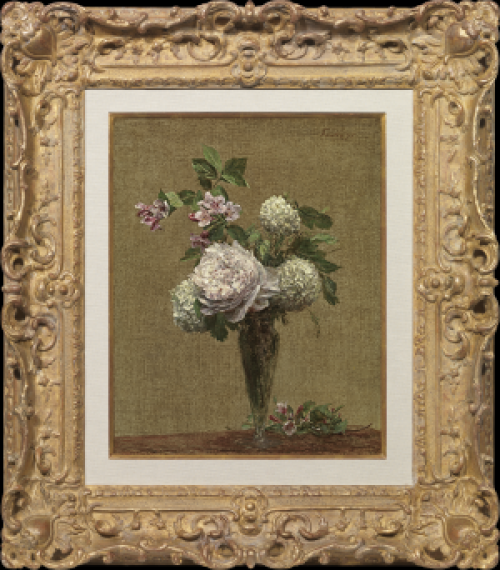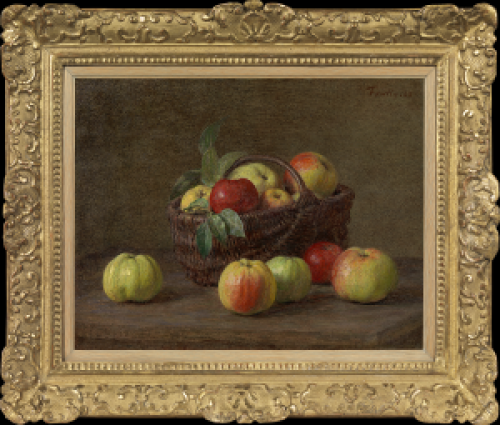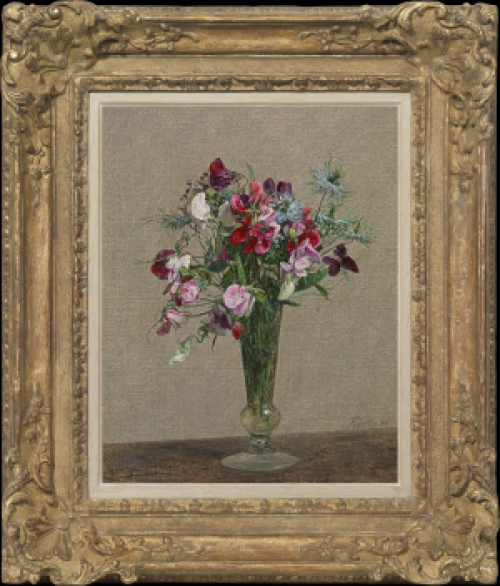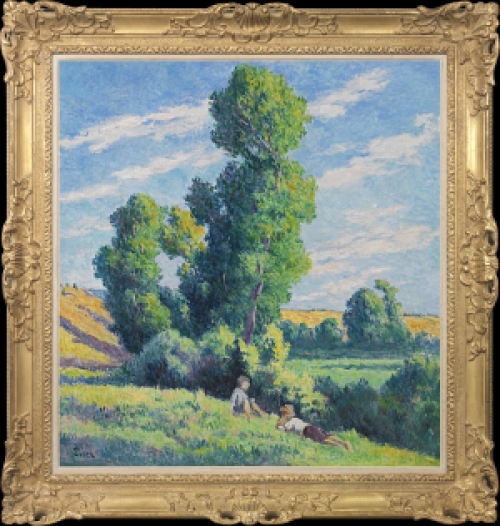EDGAR DEGAS
1834 - Paris - 1917
Ref: CB 137
Cheval marchant au pas releve
Stamped Degas; stamped with the foundry mark and numbered on the base: CIRE / PERDUE / AA HEBRARD 11/E
Bronze with brown patina: 9.1 x 8.9 x 3.4 in / 23.1 x 22.6 x 8.6 cm
On a Bronze base: 8.5 x 20.5 in / 21.6 x 52.1 cm
Original red wax model executed circa 1881; this bronze version no.11E, cast 1919-1937 (or later) in an edition of 20 numbered A to T, plus two casts reserved for the Degas heirs and the founder Hébrard, marked HER.D and HER respectively
Provenance:
Private collection, France
Literature:
J Rewald, Degas: Works in Sculpture, A Complete Catalogue, New York 1944 (London edition 1946), p.19, no.IV (another cast illus., p.39; original wax model illus., p.38) J Rewald, Degas Sculpture: the Complete Works, London 1957, p.141, no.IV (another cast illus., pl.7 and 21) F Russoli and F Minervino, L’opera completa di Degas, Milan 1970, no.S39 (another cast illus., p.143) J Rewald, Degas’s Complete Sculpture: A Catalogue Raisonné, New Edition, San Francisco 1990, no.IV (another cast illus., p.50) A Pingeot and F Horvat, Degas Sculptures, Paris 1991, no.39 (another cast illus., pp.82-83 and 172) JS Czestochowski and A Pingeot, Degas Sculptures: Catalogue Raisonné of the Bronzes, Memphis 2002, pp.143, no.11E (as untraced) (another cast illus. in colour, p.142; original wax model illus. p.143) S Campbell, R Kendall, DS Barbour and SG Sturman, Degas in the Norton Simon Museum, Pasadena 2009, vol. II, no.33 (another cast illus., pp.230-1)
This bronze has been authenticated by Brame & Lorenceau and is included in their archive of the sculptures of Edgar Degas
After Edgar Degas’s death in 1917, in the ‘indescribable chaos’ of his studio-apartment at 6 Boulevard de Clichy, the artist’s heirs were confronted with more than 150 pieces of sculpture in wax, clay and plastilene: ‘fissured…shapes, weakened and dusty’[1]. Seventy-four were deemed salvageable and were cast from 1919 onwards in bronze by Adrien Hébrard (1865-1937), one of the finest founders of his day. Each original sculpture was cast in an edition of twenty, numbered A to T, plus two casts reserved for the Degas heirs and Hébrard, marked HER.D and HER respectively. Because of the cost of casting, it is probable that the bronzes were made only when a collector requested to buy one. The present Cheval marchant au pas relevé is numbered E, indicating that it was cast early in the series.
Degas’s sculptures were deeply personal, unknown in his lifetime beyond his immediate circle, and take us to the heart of his concerns as an artist. Only one sculpture was exhibited in his lifetime: the wax Little dancer fourteen years old (National Gallery of Art, Washington DC), shown at the sixth Impressionist Exhibition in 1881. Throughout his career, however, he constantly experimented with the medium. His dealer Joseph Durand-Ruel noted that whenever he called on Degas he was ‘as sure to find him modelling in clay as painting’[2]. Degas never expected to cast or sell the sculptures, commenting that it was a ‘tremendous responsibility to leave anything behind in bronze – this medium is for eternity’[3]. The wax models found in the studio after his death mainly depict ballet dancers and horses, frequent themes of his paintings and pastels. It was only through sculpture, however, that Degas could unlock the mystery of movement that pulses through all his art.
In 1897 the critic François Thiébault-Sisson bumped into a bored and gloomy Degas in Clermont-Ferrand, where he had travelled for the sake of his health. Over an excellent lunch and on two subsequent days, the artist spoke wittily and candidly about the struggles of his profession, giving a penetrating insight into his impulses as a sculptor. He admitted that from the 1860s, ‘while I happened fairly frequently to mount [a horse]…whereas I was quite familiar with the anatomy and myology of the animal…I was totally ignorant of the mechanism that regulated a horse’s movements…The older I became, the more clearly I realized that to achieve exactitude so perfect in the representation of animals that feeling of life is conveyed, one had to go into three dimensions, not merely because the activity itself requires prolonged observation from the artist…but also because this is an area in which approximations are unacceptable’[4].
Cheval marchant au pas relevé is among the most completely realised and graceful of Degas’s horse sculptures. The animal moves with lightness and confidence, alert, ears pricked forwards, mouth open, as if whinnying to a companion across a field. Degas’s experimental, instinctive way of building up the wax over a metal armature is faithfully reproduced in the bronze[5]. One can almost sense the artist’s hands pushing against the wax medium, stroking muscles into place, quickly modelling the swishing tail. Vitality courses through the work. Degas was not interested in the smooth perfection achieved by contemporary animalier sculptors serving their bourgeois audience: ‘What matters to me is to express nature in all of its aspects, movement in its exact truth, to accentuate bone and muscle and the compact firmness of flesh’[6].
Degas was fascinated by the power and beauty of horses all his life. He drew Roman sculptures of horses while in Italy 1856-59. The wax and clay Study of a mustang, executed in 1859-60 (Virginia Museum of Fine Arts, Collection of Mr and Mrs Paul Mellon) is his first surviving sculpture. Degas was an aficionado of the Turf, frequenting the racecourse at Longchamp on the western edge of Paris, which opened in 1857. Like the Opera-Ballet, which also provided so many of Degas’s themes, the racecourse was an ideal subject of ‘modern life’: intimate yet impersonal, elegant yet brutal, presenting tableaux as well as the opportunity to observe the most extreme, skilled forms of movement. In the recording of horses’ anatomy and spirit, Degas had the example of the great Romantic artist Théodore Géricault (1791-1824), whose horse portraits smashed the static mould of eighteenth century ‘sporting painting’. The excitement, the mixing of social classes, the sexually-charged atmosphere of the race meeting was not lost on genre painters such as Jean Béraud and William Powell Frith, and on contemporary novelists. Zola’s Nana parades at the races; Tolstoy builds one of the great set-pieces of Anna Karenina (1878) round a race meeting. Degas’s bronze Cheval marchant au pas relevé strips away everything and gives us just the essence: a beautiful animal in motion, utterly heedless, utterly expressive of itself.
EDGAR DEGAS
1834 - Paris - 1917
Hilaire-Germain-Edgar De Gas was born in Paris on 19th July 1834, into a Franco-Italian family. His father Auguste, a banker, was French; his mother, Celestine, from New Orleans. Branches of the De Gas family in both Paris and Naples had changed their name from Degas to enhance their social status. Degas reverted to the original spelling around 1870.
Degas received a classical education at the Lycée Louis-le-Grand in Paris, destined for a future as a lawyer. Instead he copied Italian Old Masters at the Louvre and in 1854 became a pupil of Louis Lamothe (1822-1869), a former student of Jean-Auguste-Dominique Ingres, as well as attending the Ecole des Beaux-Arts 1855-56. Academically trained and a superb draughtsman, Degas aimed to be a classical painter of modern life. He said: ‘My art has nothing spontaneous about it, it is all reflection’.
From 1856 to 1859 Degas was in Italy, spending time in Naples and Florence with his aunt, the Baroness Bellelli, whose family he painted (The Bellelli family, 1858-67; Musée d’Orsay, Paris). He travelled extensively in Italy, studying the Old Masters. Back in Paris, he exhibited history pictures. A visit to his cotton-broking relatives in New Orleans produced Cotton market at New Orleans, 1873 (Musée des Beaux-Arts, Pau), a modern-life subject of a type that increasingly interested him. He also portrayed scenes at the ballet and the races, fascinated by ways in which to capture movement in a naturalistic manner.
Degas had met Edouard Manet while copying pictures at the Louvre in 1862 and through him was introduced to the group that would become known as the Impressionists. He exhibited at the first ‘Impressionist’ exhibition in 1874 and at six of their subsequent shows, although he always thought of himself as a Realist or Naturalist. He disliked painting en plein air, preferring to make multiple sketches and use a mixture of these and memory to work up compositions in the studio. Informal sketches allowed Degas to capture the ‘naïve spontaneity of behaviour’ which he sought.
Degas experimented with techniques in many media. He made clay sculptures on armatures of wire, both of dancers and horses, to develop his understanding of movement. He was hugely influenced by Eadweard Muybridge, whose photographs of racehorses finally unlocked the secret of how they move. Little fourteen-year-old dancer (National Gallery of Art, Washington DC), a polychrome wax sculpture, with real tutu and ribbon, of one of the petit rats of the Opéra Ballet, shown at the Sixth Impressionist Exhibition in 1881, caused outrage for its avant-garde technique and unvarnished depiction of the ‘low-life’ subject.
By the 1880s Degas was a well-established figure in the Parisian art world. Financial security allowed him to be selective about where he sold his work. After the final Impressionist Exhibition in 1886, he sold only through chosen dealers such as Durand-Ruel, Hector Brame and Ambroise Vollard. In this decade he developed pictures on the theme of women working – ironers, laundresses and milliners – or during intimate moments at home, such as bathing. Many of these works are executed in pastel. In the 1890s Degas moved away from Naturalism with compositions such as Combing the hair (La coiffure), c.1896 (National Gallery, London), which use a high, anti-naturalistic colour key and rhythmic, expressive line, a style akin to Symbolism. Degas was influenced by younger artists, such as Paul Gauguin at this period, but also had huge influence on artists of a younger generation, among them Pablo Picasso. Depressed by failing eyesight and an enforced move from his beloved (if chaotic) studio, Degas produced his last works in 1912. He died in Paris in 1917.
The work of Edgar Degas is represented in many collections including the Musée d’Orsay, Paris; the Metropolitan Museum of Art, New York; the Museum of Fine Arts, Boston; the J Paul Getty Museum, Los Angeles; the Thyssen-Bornemisza Museum, Madrid; the State Hermitage Museum, St Petersburg and the National Gallery, London.
[1] François Thiébault-Sisson, ‘Degas, the sculptor, tells his own story’, Le Temps, 23rd May 1921, p.3; quoted in Czestochowski and Pingeot 2002, op. cit., p.278.
[2] Quoted in Washington DC, National Gallery of Art, Degas at the Races, exh. cat. by Jean Sutherland Boggs et al., 1998, in Daphne S Barbour and Shelley G Sturman, ‘The Horse in Wax and Bronze’, p.180.
[3] Quoted in Barbour and Sturman, op. cit., p.180.
[4] Quoted in Czestochowski and Pingeot, op. cit., p.277.
[5] The original red wax model for Cheval marchant au pas relevé was given by Mr and Mrs Paul Mellon to the Virginia Museum of Fine Arts.
[6] Quoted in Czestochowski and Pingeot, p.278.


